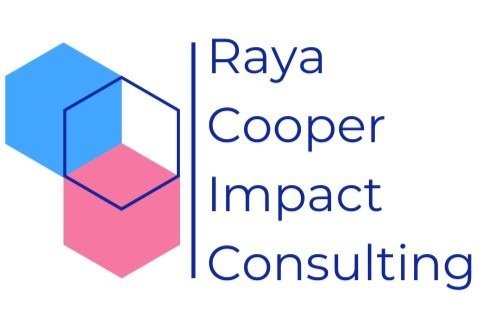Materiality Assessment & Theory of Change - Using them together for greater impact
Authors: Slavi Stevanovic (Qatalyst Research Group, Inc), Alissa May (A. May Consulting), Morgan Buras-Finlay (Raya Cooper Impact Consulting).
This piece is also published at Qatalyst Research Group blog
Imagine you're a company or organization that has made some kind of commitment to making a positive change for people or the planet. This could mean supporting employee well-being, reducing carbon emissions, or funding organizations fighting poverty in your region. Whether it's an internal goal or a public statement, there's growing pressure to prove the value you're creating (and risk you’re avoiding) for stakeholders, communities, and shareholders. It's no longer enough to say, "We're doing XYZ"; you need to back it up with data and evidence. Plus, with limited resources, it's crucial to invest in programs that actually work. This requires a smart approach to decision-making.
If you're familiar with the social impact world, you've likely heard of both Materiality Assessments and Theory of Change. These concepts are essential for setting priorities, reporting on impact and sustainability, and showing their value. They help organizations clearly communicate their goals, engage with stakeholders, and enhance positive impacts while mitigating negative ones. While often thought of separately, these tools can actually be used together to help organizations strengthen their communication, impact strategies, and stakeholder engagement.
But first…definitions!
Materiality Assessments help companies identify and prioritize environmental, social, and governance issues that are material to the business and create appropriate disclosure and reporting structures. These assessments can help guide decisions on managing impacts, allocating resources, and meeting stakeholder expectations. However, regulations can vary by geography. In the European Union, the Corporate Sustainability Reporting Directive (CSRD) requires companies to conduct "double materiality" assessments, which look at both how the company impacts the environment (inside-out) and how external factors impact the company (outside-in).i Materiality assessments are important for companies for several reasons including the company’s alignment with the most relevant ESG issues, risk management, stakeholder engagement, compliance and reporting, competitive advantage, and long-term sustainability.
The Logic Model and the Theory of Change are both frameworks used in strategic planning, evaluation, and impact measurement particularly in the fields of international development, nonprofit management, and public policy. Theory of Change (TOC) explains the logical connections between an intervention and its desired outcomes, helping organizations track progress. A logic model visually represents the inputs, activities, outputs, and outcomes of a program, ensuring alignment between these elements.
The Importance of Stakeholder Engagement
Engaging a variety of stakeholders is essential for the success of any goals derived from these frameworks. This involves connecting with people both inside and outside the organization who are affected by your actions. Effective stakeholder engagement requires careful planning and strategy, and it's an evolving process that needs continuous refinement.
Using TOC and Materiality Frameworks Together
There are clear benefits to integrating TOC, logic models, and materiality assessments:
Set clear goals and priorities: Materiality assessments identify key sustainability issues, and TOC links these issues to desired changes.
Allocate resources effectively: Ensure resources are directed towards impactful activities. ▪ Build stakeholder trust: Demonstrate commitment and progress to stakeholders
Meet regulatory requirements: Align with regulations and standards.
Let’s do it together, step-by-step.
STEP 1 : Engage Stakeholders
Identify key stakeholder groups like customers, employees, investors, and community members. “For effective stakeholder management, it’s critical to identify which stakeholders matter the most to the company. A good pressure test to prioritize different stakeholder groups is to consider three features: power, legitimacy, and urgency.” (Fortune). Through this process, you’ll identify the 3-5 material issues to focus on and measure.
STEP 2 : Conduct the Double Materiality Process
This step helps you to narrow down what is important to the financial health of your organization and to your impact on the world around you. This will also guide you in how you are going to structure your metrics and reporting. This is not just for corporations or non-profits, this applies to you, too! The financial health and impact of your organization are just as important as a publicly traded company on the stock exchange or a private equity-backed company.
Determine what's important for your organization's financial health and its impact on the world. This step guides how you structure metrics and reporting. Distill your material issues down to three or so main focus metrics and measurements in each of the three topical areas: environmental, social and governance. Although nonprofits are not bound by these regulations, it can be a worthwhile exercise to go through to get clarity about what is material at your organization.
STEP 3 : Connect Your Theory of Change
Link your identified materiality issues to TOC outcomes and impacts. If you already have a TOC, identify connections. If not, build one around your materiality topics. This creates a clear story of how your organization is working towards its goals, supporting strategy, communications, marketing, and more.
Now hopefully, you can see how these two can work together to create a well-rounded and focused impact strategy that connects the material issues with intended outcomes, and a plan for measurement. What is this organization driving towards? A climate-conscious emission reduction commitment and an equitable and representative workforce and community that they serve.
By integrating TOC and Materiality Frameworks, you develop a comprehensive impact strategy that drives positive change and demonstrates your commitment to stakeholders. This clarity of purpose and goals supports everything from strategy to brand positioning.
Sources & Resources
KPMG - The essentials of materiality assessment
Telefónica - Double Materiality: its importance and how we apply at it Telefónica






